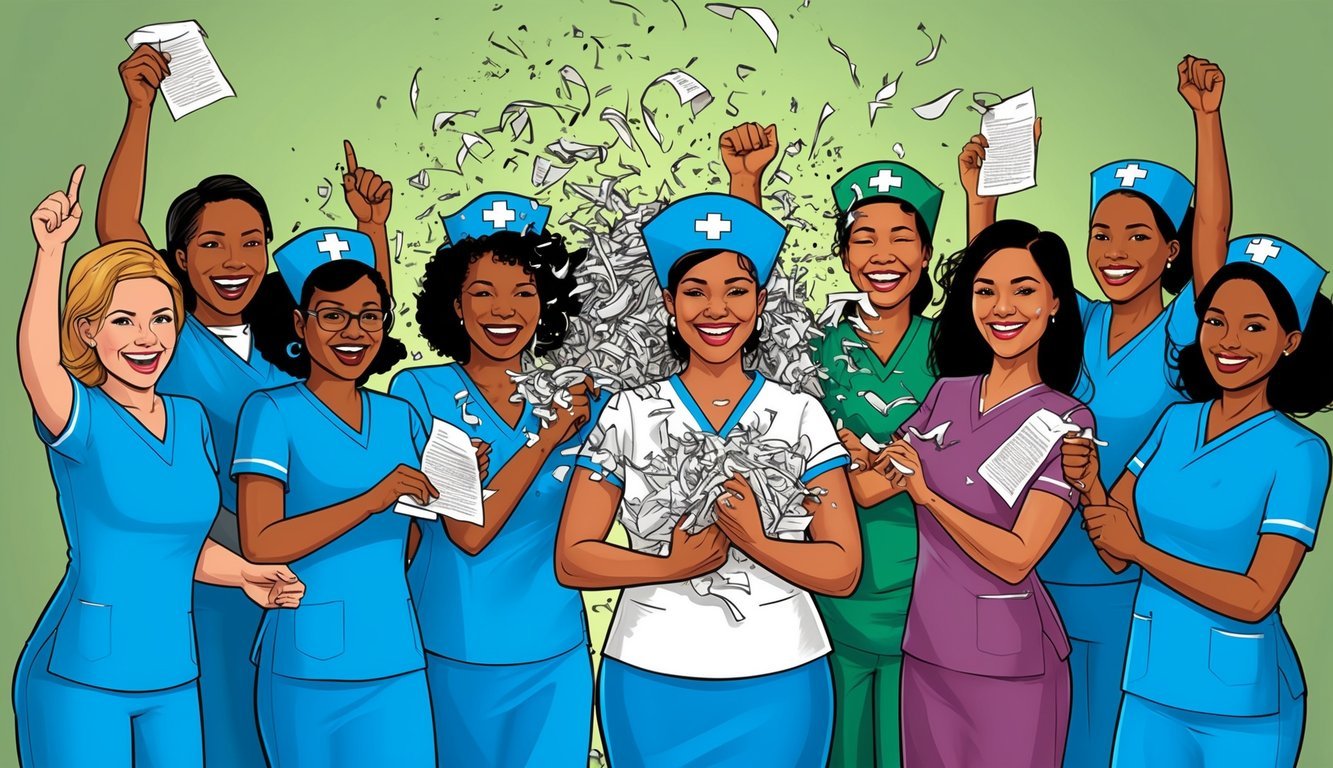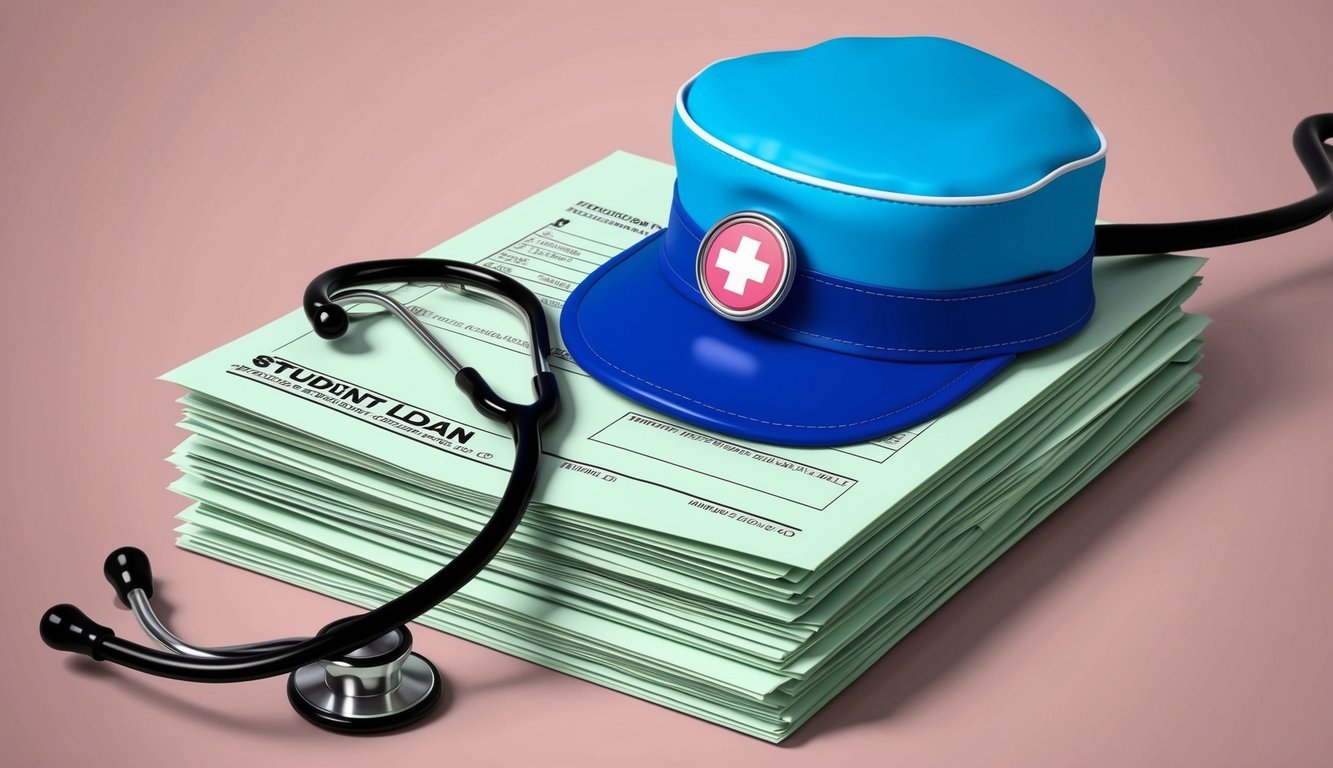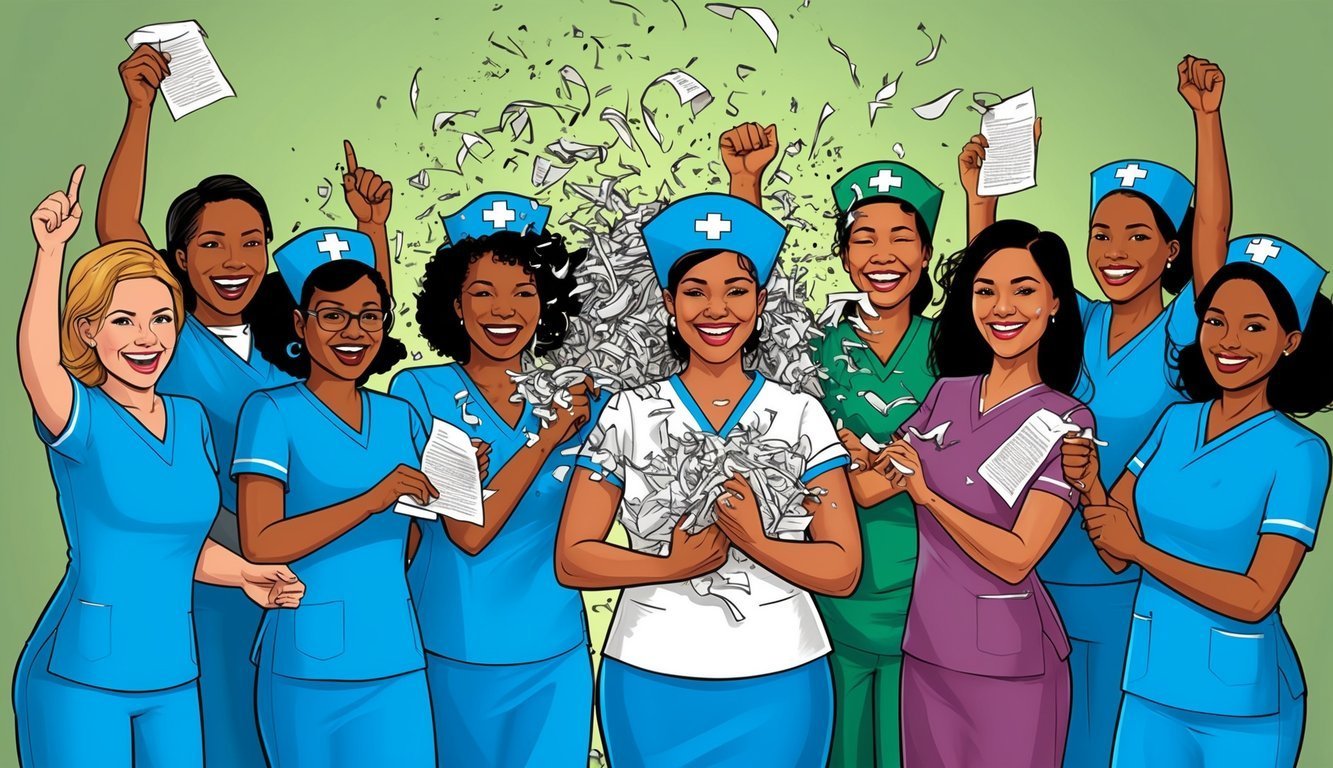As a dedicated nurse, managing student loan debt can feel overwhelming.
Fortunately, specific programs are designed to alleviate this burden through student loan forgiveness for nurses.
If you work in certain public service roles or meet specific criteria outlined by various forgiveness programs, you may qualify for substantial debt relief. 
Various options exist to help nurses tackle their student loans more effectively.
Programs like the Public Service Loan Forgiveness (PSLF) allow you to qualify for forgiveness after making a set number of payments while working in a qualifying job.
Additionally, initiatives such as the National Health Service Corps (NHSC) Loan Repayment Program offer financial assistance to nurse practitioners in exchange for service in underserved areas.
Exploring these opportunities is essential to manage your student debt strategically while pursuing your nursing career.
Understanding the eligibility and requirements of these programs can help you make informed decisions about your financial future and focus more on your passion for patient care.
Understanding Student Loan Forgiveness for Nurses
Navigating student loan forgiveness options can significantly ease your financial burden as a nurse.
Various federal programs exist to assist you in managing the debt incurred from nursing school, ensuring you can focus more on your career and patient care.
Federal Loan Forgiveness Programs
Federal loan forgiveness programs are essential for nurses seeking financial relief.
These programs can help reduce or eliminate federal student loan debt for qualified individuals.
Your eligibility often depends on factors such as your employment setting and loan type.
The U.S. Department of Education outlines specific criteria for these programs, which typically require a commitment to work in underserved areas or for nonprofit organizations.
To apply, complete appropriate forms and document your employment.
Additionally, keeping track of your payments and qualifying circumstances is crucial for successful forgiveness.
Nurse Corps Loan Repayment Program
The Nurse Corps Loan Repayment Program is specifically designed to enhance nursing services in high-need areas.
If you commit to working in a Health Professional Shortage Area (HPSA), you can receive loan repayment assistance for up to 85% of your total outstanding student loans.
Eligible applicants must be licensed registered nurses or advanced practice nurses.
You will need to work at a critical shortage facility or HPSA for at least two years.
Payments are made directly to the loan servicer, making it easier for you to manage your debt.
Be sure to check the application timeline and prepare documentation related to your nursing qualifications.
Public Service Loan Forgiveness (PSLF)
The Public Service Loan Forgiveness (PSLF) program is an excellent opportunity for nurses employed by government or nonprofit organizations.
After you make 120 qualifying monthly payments under a qualifying repayment plan, you may have the remaining balance of your Direct Loans forgiven.
To qualify, you must work full-time for an eligible employer and have Direct Loans.
It’s crucial to submit the Employment Certification Form annually to ensure you are on track.
This program is beneficial for those committed to public service and can significantly alleviate long-term debt.
Check the PSLF guidelines for detailed eligibility criteria and application procedures.
Perkins Loan Cancellation Program
The Perkins Loan Cancellation Program offers a path to forgiveness for Perkins Loans, specifically for nurses and other educators.
You may qualify for cancellation of your loan if you serve in a qualifying profession or in certain institutions.
To benefit, you usually need to complete a period of service, such as working in a low-income school or with underserved populations in healthcare settings.
Generally, you can cancel up to 100% of the loan over a specified period of service.
Ensuring timely paperwork is essential to track your service and submit it according to the requirements set by the U.S. Department of Education.
For more details, review the specifics of the Perkins Loan Cancellation Program within the Department of Education site.
Eligibility Requirements for Loan Forgiveness
Understanding the specific eligibility requirements for student loan forgiveness programs is crucial for nurses.
Different programs have distinct qualifications and criteria that you must meet to qualify for debt relief.
Qualifications for PSLF
To qualify for the Public Service Loan Forgiveness (PSLF) program, you need to meet several key criteria.
First, you must work full-time for a qualifying employer, which includes government organizations or non-profit entities.
You also need to have Direct Loans or consolidate your loans into Direct Loans.
Make at least 120 qualifying monthly payments under a repay plan while employed in a qualifying job.
Additionally, ensure that your loan servicer is aware of your PSLF eligibility.
You can verify your qualifying employment with the PSLF Help Tool for comprehensive support.
Requirements for Nurse Corps LRP
The Nurse Corps Loan Repayment Program (LRP) is designed to assist Registered Nurses and Advanced Practice Registered Nurses.
To qualify, you must work in designated health professional shortage areas (HPSAs).
You need a valid nursing degree from an accredited institution and must commit to serving in a critical shortage facility for at least two years.
The program pays up to 85% of your unpaid nursing education loans.
Keep in mind that you must be a U.S. citizen or a National to be eligible.
More details can be found on the Nurse Corps LRP website.
Other Federal Forgiveness Program Criteria
Various federal loan forgiveness programs exist aside from PSLF and Nurse Corps LRP.
For instance, if you are a nurse faculty member, you may qualify for the Faculty Loan Repayment Program.
To be eligible, you must agree to teach at an accredited nursing school for at least two years.
Other criteria may include having qualifying federal student loans and providing evidence of your commitment to serving disadvantaged communities.
Each program has unique criteria, so reviewing the specifics for programs like the Disadvantaged Faculty Loan Repayment Program is critical before applying.
Application Process for Nursing Loan Forgiveness
Navigating the application process for nursing loan forgiveness requires careful attention to detail.
You will need to gather necessary documentation, complete required forms, and utilize customer service resources effectively.
Gathering Documentation
Before starting your application, collect key documents that demonstrate your eligibility.
These may include:
- Proof of employment at a qualifying facility
- Copies of your nursing degree and licensure
- Documentation of your outstanding loan balance
Confirm that all documents are from accredited sources and up to date.
You may need to provide a detailed breakdown of your loans, including their terms and current status.
Many programs, including the Nurse Corps Loan Repayment Program, require that your nursing education comes from an accredited institution.
Familiarizing yourself with the specific requirements of the program you are applying to is essential.
Submitting Forms
Once you have gathered your documentation, the next step is to complete and submit the necessary forms.
Be mindful of application deadlines, as most programs, such as the Nurse Corps Loan Repayment Program, operate on an annual cycle with a set submission date.
Ensure that you fill out all forms completely and accurately and include all required supporting documentation.
Also, check for specific submission instructions, whether online or by mail.
Missing deadlines or failing to provide necessary documentation can lead to delays or rejection.
Utilize official program resources to double-check your application’s completeness before submission.
Customer Service Portal Usage
Utilizing the customer service portal is a critical aspect of the application process.
Most loan forgiveness programs provide access to a dedicated portal for assistance.
Here’s how to make the most of it:
- Login: Create an account or log in using your existing credentials.
- Track Your Application: Use the portal to monitor the status of your application.
- Seek Assistance: If you have questions, take advantage of live chat or support ticket options.
These portals often have FAQs that address common concerns, which can save you time.
For issues that require additional help, make sure to document your inquiries for future reference.
Having a reliable line of communication can streamline your experience with the application process.
Income-Driven Repayment Plans and Loan Forgiveness
Income-driven repayment (IDR) plans are designed to make your monthly payments more manageable based on your income.
Understanding how these plans work and their connection to loan forgiveness can significantly benefit your financial situation, especially as a nurse balancing education debt.
Understanding IDR Plans
Income-driven repayment plans calculate your monthly student loan payments based on your discretionary income.
This means your payments may be as low as 5% to 10% of your income, making them more affordable.
There are four primary IDR plans available to federal student loan borrowers:
- Saving on a Valuable Education (SAVE) Plan
- Pay As You Earn (PAYE) Plan
- Income-Based Repayment (IBR) Plan
- Income-Contingent Repayment (ICR) Plan
Enrolling in an IDR plan allows you to align your payments with your earnings, which can be especially useful when your nursing salary fluctuates or your debt is high in relation to your income.
Linkage Between IDR and Forgiveness
One of the most significant advantages of IDR plans is the potential for loan forgiveness.
If you consistently make your payments under an IDR plan, the remaining balance on your federal loans can be forgiven after:
- 20 years for undergraduate loans
- 25 years for graduate loans
This forgiveness is particularly important for nurses, as you may face substantial education debt.
Regular payments throughout the forgiveness period can lead to significant financial relief.
Additionally, the IDR plan you’re enrolled in impacts the timeline for forgiveness.
The newer SAVE Plan specifically enhances forgiveness options, making it a strong choice for many borrowers.
Calculating Discretionary Income
Discretionary income is a key factor in determining your monthly payments under IDR plans.
It is calculated as your Adjusted Gross Income (AGI) minus 150% of the federal poverty guideline for your household size.
This calculation directly influences how much you pay each month.
Here’s a simplified formula:
Discretionary Income = AGI – (150% of Federal Poverty Level)
For example, if your AGI is $50,000 and the poverty level for your family is $20,000:
Discretionary Income = $50,000 – ($20,000 * 1.5) = $50,000 – $30,000 = $20,000
Based on this income, your payments would be calculated accordingly, potentially leading to lower monthly payments.
For more detailed calculations and information, consult Federal Student Aid.
Financial Implications of Student Loan Forgiveness

Considering the specifics of student loan forgiveness can significantly affect your financial situation.
Understanding the implications can help you navigate your options effectively.
Impact on Personal Finances
Student loan forgiveness programs, such as the Public Service Loan Forgiveness (PSLF), directly affect your personal finances.
By having all or part of your federal loans forgiven, you gain immediate financial relief that can enhance your monthly budget.
For example, if you have $50,000 in student loans and qualify for forgiveness of $40,000, that’s a substantial saving.
This relief can allow more room for essential expenses and savings.
Additionally, you may redirect what you would have spent on loan payments towards retirement, investments, or homeownership.
Over time, this can lead to increased financial stability and growth.
Tax Considerations
Student loan forgiveness eases debt burden, but you must consider associated tax implications.
Generally, forgiven student debt is considered taxable income.
However, the American Rescue Plan has temporarily exempted federal student loan forgiveness from taxation until 2025.
For example:
| Year | Taxable Status |
|---|---|
| 2024 | Non-Taxable (due to legislation) |
| 2025 | Potential future income |
Consult with a tax professional to assess your unique situation.
Prepare for possible tax impacts after the non-tax status ends.
Long-Term Debt Relief
Receiving student loan forgiveness can lead to long-term financial benefits.
Paying off your loans allows you to build and improve your credit score over time.
A higher credit score opens up better interest rates on mortgages, car loans, and personal loans.
Furthermore, student debt relief can also help you save more effectively.
You can save through individual retirement accounts or emergency funds.
Participating in programs focusing on income-driven repayment, such as the Saving on a Valuable Education (SAVE) Plan, can also provide additional debt relief options tailored to your income level, ensuring sustainable financial health.
Make sure to evaluate all options and stay informed about any changes in policy regarding student loan relief or other relevant programs.

